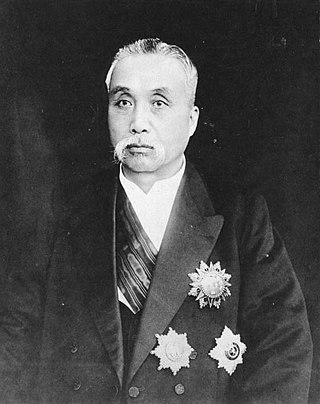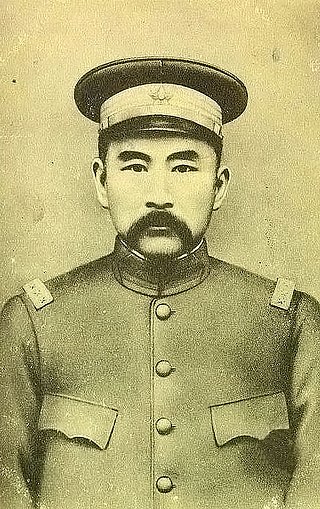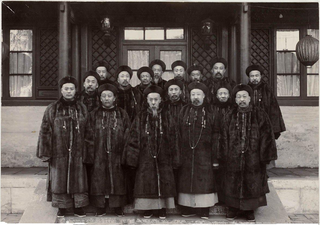
Yuan Shikai was a Chinese general and statesman who served as the second provisional president of the Republic of China, head of the Beiyang government from 1912 to 1916 and Emperor of China from 1915 to 1916. A major political figure during the late Qing dynasty, he spearheaded a number of major modernisation programs and reforms and played a decisive role in securing the abdication of the Xuantong Emperor in 1912, which marked the collapse of the Qing monarchy and the end of imperial rule in China.

Xu Shichang was a Chinese politician who served as the President of the Republic of China, in Beijing, from 10 October 1918 to 2 June 1922. The only permanent president of the Beiyang government to be a civilian, his presidency was also the longest of the Warlord Era. Previously, he was Minister of the Cabinet of the Imperial Cabinet during the Qing Dynasty.

The 1911 Revolution, also known as the Xinhai Revolution or Hsinhai Revolution, ended China's last imperial dynasty, the Qing dynasty, and led to the establishment of the Republic of China. The revolution was the culmination of a decade of agitation, revolts, and uprisings. Its success marked the collapse of the Chinese monarchy, the end of over two millennia of imperial rule in China and over 200 years of the Qing dynasty, and the beginning of China's early republican era.

Huang Xing or Huang Hsing was a Chinese revolutionary leader and politician, and the first commander-in-chief of the Republic of China. As one of the founders of the Kuomintang (KMT) and the Republic of China, his position was second only to Sun Yat-sen. Together they were known as Sun-Huang during the Xinhai Revolution. He was also known as the "Eight Fingered General" because of wounds sustained during war. His tomb is on Mount Yuelu, in Changsha, Hunan, China.

Li Yuanhong was a Chinese politician during the Qing dynasty and the Republic of China. He was the president of the Republic of China between 1916 and 1917, and between 1922 and 1923.

The Beiyang Army, named after the Beiyang region, was a large, Western-style Imperial Chinese Army established by the Qing dynasty government in the late 19th century. It was the centerpiece of a general reconstruction of Qing China's military system. The Beiyang Army played a major role in Chinese politics for at least three decades and arguably right up to 1949. It made the Xinhai Revolution of 1911 possible, and, by dividing into warlord factions known as the Beiyang Clique, ushered in a period of regional division.

Sheng Xuanhuai was a Qing dynasty Chinese tycoon, politician, and educator. He founded several major banks and universities and served as Minister of Transportation of the Qing Empire. He was also known as Sheng Gongbao.

Yikuang, formally known as Prince Qing, was a Manchu noble and politician of the Qing dynasty. He served as the first Prime Minister of the Imperial Cabinet, an office created in May 1911 to replace the Grand Council.

Admiral Du Xigui was a Chinese naval officer during the late Qing dynasty and the Warlord Era.
The Constitutional Protection Movement was a series of movements led by Sun Yat-sen to resist the Beiyang government between 1917 and 1922, in which Sun established another government in Guangzhou as a result. It was known as the Third Revolution by the Kuomintang. The constitution that it intended to protect was the Provisional Constitution of the Republic of China. The first movement lasted from 1917 to 1920; the second from 1921 to 1922. An attempted third movement, begun in 1923, ultimately became the genesis for the Northern Expedition in 1926.

Zhang Xun, courtesy name Shaoxuan (少軒), art name Songshoulaoren (松壽老人), nickname Bianshuai, was a Chinese general and Qing loyalist who attempted to restore the abdicated emperor Puyi in the Manchu Restoration of 1917. He also supported Yuan Shikai during his time as president.

Sun Baoqi was a government official, foreign minister, and premier of the Republic of China. His courtesy name was Mu-han (慕韓)

Sa Zhenbing was a prominent Chinese admiral of the late Qing dynasty and the early Republic. He lived through four governments in China, and had been appointed to various senior naval and political offices.

Late Qing reforms, commonly known as New Policies of the late Qing dynasty, or New Deal of the late Qing dynasty, simply referred to as New Policies, were a series of cultural, economic, educational, military, diplomatic, and political reforms implemented in the last decade of the Qing dynasty to keep the dynasty in power after the invasions of the great powers of the Eight Nation Alliance in league with the ten provinces of the Southeast Mutual Protection during the Boxer Rebellion.
The following lists events that happened during 1911 in China.

The Prime Minister of the Imperial Cabinet was a position created on 8 May 1911 during the late Qing dynasty, as part of the imperial government's unsuccessful attempts at creating a constitutional monarchy in China.

The Cabinet of Prince Qing was the first cabinet of the Qing dynasty and of China, formed as part of the Qing state's reforms to create a constitutional monarchy in the early 20th century. It was active from 8 May to 1 November 1911, led by the Prime Minister of the Imperial Cabinet, Yikuang. It initially consisted of thirteen members, of which nine were Manchus while only four were Han Chinese. As a result, it remained unpopular among the people and was nicknamed the "Princes' Cabinet" or "Imperial Family Cabinet"(皇族内阁; 皇族內閣; Huángzú Nèigé) by its critics.
The Imperial Edict of the Abdication of the Qing Emperor was an official decree issued by the Empress Dowager Longyu on behalf of the six-year-old Xuantong Emperor, the last emperor of the Qing dynasty of China, on 12 February 1912, as a response to the Xinhai Revolution. The revolution led to the self-declared independence of 13 southern Chinese provinces and the subsequent peace negotiation between the rest of Qing China and the collective of the southern provinces.

The Articles of Favourable Treatment of the Great Qing Emperor after His Abdication, also known simply as the Articles of Favourable Treatment, was an agreement drawn up by the Qing dynasty government and the Provisional Government of the Republic of China on the relevant protection measures after the abdication of the Qing imperial family and the Xinhai Revolution. The document is dated 26 December, 1914.
















